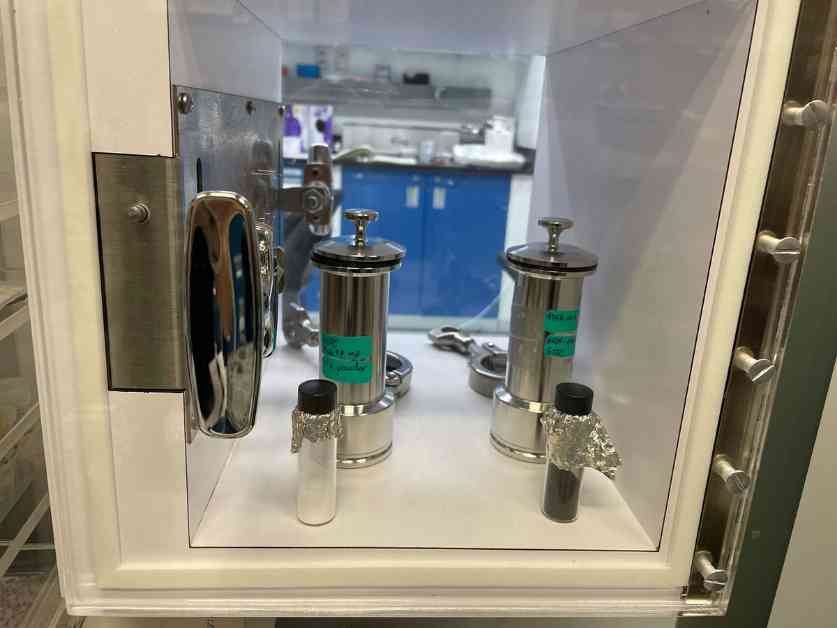Unveiling the Secrets of Life: Scientists’ Quest with Four Grams of Asteroid Dust
NASA researchers are currently delving into the mysteries contained within rocks and dirt that were brought to Earth from the asteroid Bennu. This groundbreaking research is part of the OSIRIS-REx mission, which successfully returned a spacecraft to Earth last September carrying a tiny cargo of 121.6 grams of asteroid material. Among this precious cargo is approximately four grams of rocks and dirt scooped from Bennu, a celestial body that holds significant clues to the origins of life on Earth.
The OSIRIS-REx mission, with the “O” standing for “Origins,” is particularly focused on unraveling the beginnings of life on our planet. Tim McCoy, curator of meteorites at the Smithsonian’s National Museum of Natural History, highlighted the importance of the samples from Bennu, stating that they represent the “feedstock of life” and are integral to understanding the formation of oceans and all life as we know it. The rocks and minerals from Bennu are among the oldest materials on Earth, having witnessed the creation of the solar system billions of years ago.
At the NASA Goddard Space Flight Center in Maryland, scientists are conducting a series of tests to analyze the asteroid material brought back by the OSIRIS-REx spacecraft. The samples are being meticulously examined in the Astrobiology Analytical Laboratory inside Building 34, where researchers are eager to unlock the secrets held within these ancient rocks. The journey of the spacecraft to collect these samples spanned over 3.86 billion miles and took seven years to complete, underscoring the significance of the scientific endeavor.
###Delving into Pristine Asteroid Material
The samples from Bennu are considered to be pristine, untouched by the geologic and biological processes that have altered materials on Earth over time. This pristine nature makes them invaluable for studying the origins of life and understanding the composition of celestial bodies like asteroids. Inside the Astrobiology Analytical Laboratory, strict protocols are followed to maintain the integrity of the asteroid material, ensuring that it remains uncontaminated by earthly elements.
Jason Dworkin, the lab director, emphasizes the importance of studying meteorites and asteroids to uncover the raw materials that contributed to the formation of planets in our solar system. The Bennu samples offer a unique opportunity to explore the organic molecules present in the asteroid, shedding light on how asteroids like Bennu played a role in the development of nucleic acids and other essential components for life on Earth. The scientists at the lab are dedicated to piecing together the full biography of Bennu, with samples being distributed among 38 scientific institutions worldwide for comprehensive analysis.
###Investigating Organic Molecules and Mineralogy
One of the key objectives of the research at the Astrobiology Analytical Laboratory is to understand how asteroids like Bennu may have contributed to the formation of life on Earth. By studying the organic molecules present in the samples, researchers hope to uncover the role of asteroids in the development of nucleic acids, RNA, and DNA. The mineralogical analysis of the Bennu samples has revealed intriguing components like magnesium-sodium phosphates, which can participate in chemical reactions and potentially contribute to the formation of organic compounds necessary for life.
Danny Glavin, a senior scientist involved in NASA’s sample return missions, highlights the significance of the phosphates found in the Bennu samples, linking them to the structural units of nucleic acids. These findings open up new avenues for exploring the potential contributions of asteroids to the complex chemistry that led to the emergence of life on Earth. The organic compounds discovered in the Bennu samples, including amino acids like glycine, provide valuable insights into the building blocks of life that may have originated from extraterrestrial sources.
###Unlocking the Mysteries of the Universe
As scientists continue to analyze the Bennu samples, asteroids have become a focal point of astronomical research and exploration. The OSIRIS-REx spacecraft is embarking on a new mission to the asteroid Apophis, while other NASA probes are also journeying to different celestial bodies for further study. The discoveries made from these missions not only deepen our understanding of the cosmos but also pave the way for future generations of scientists to unravel the mysteries of the universe.
The ongoing research at the Astrobiology Analytical Laboratory represents a significant step forward in our quest to unveil the secrets of life and understand the origins of our existence. By studying the ancient rocks and minerals brought back from Bennu, scientists are piecing together the intricate puzzle of how life on Earth began and the role that asteroids played in shaping our planet’s history. The samples from Bennu hold the key to unlocking a wealth of knowledge about the formation of our solar system and the fundamental processes that led to the emergence of life as we know it.













